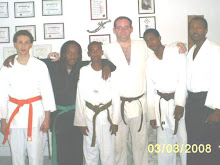My first art of falling was simply an effort of not getting hurt by my older and much wiser sempai of the Kenjote Taijutsu Ryu. For the first two years under Sensei Takemura all I did was watch and play the role of Uke and in those days we had no mats to land on, only the unforgiving nature of the ground.
Sensei would always say, "Become soft and yield!" I had no idea what he meant. What I did know was that everytime I resisted the throw, things hurt very badly. When I gave up fighting the techniques and realized when I was off balance and became "soft" with the throw, IT DIDN'T HURT. No matter how hard they would throw me (and they would really try to plant you), I was able to get up and continue with another attack.
This realization bought on another: If I became soft with an attack, I could direct it away from me and set my attacker up for all sorts of nasty little things.
So, the art of falling is more than just "falling", it is a way for us to know ourselves, our limitations, and it gives us the tools to overcome all that wishes to harm us.
Some people distinguish falling as the Aikikai way or the Kodokan way, I have no preference as to which my students use as long as it results with a safe landing. I teach ukemi in the manner in which I learned it and that would be classified as the Kodokan way, but let the truth be told, I use both depending on the situation.
What I would like for my students to get is a natural feeling of "going with the flow" of things. This realization will lead to greater randori practices and even better aikidoka. How can we learn to protect ourselves from attack completely if we can't finish the technique completey? We can not if we must stop before the throw. We must practice as we will do, we must be able to follow through with all of our efforts if we are to evolve as martial artist and we can only do this if we have trained and willing partners to learn from.
We must all train hard in ukemi and value its importance, without it our aikido practice fails us. Without it we are simply dancing.
Ngakpa Sensei

- Silent Dragon
- Poinciana, Florida, United States
- Althought I "attempt" to teach I remain a student and my students become my teachers. I am from East Stuart, Fl (across the tracks) and there the seed was planted. I recieved training in the art of Kenjote Taijutusu from the Honorable Martial Monk Kinjo Takemura Kaijo until his death in 1987, he taught me many things and I loved him. I served in the US Army as an infantryman in the middle east and had the unfortunate opportunity to utilize those skills to return home in one piece, so to speak. For years after that I continued to teach but sought something else and eventually found "it".....AIKIDO. I placed my ragged black belt into the closet and donned the white one, with Kevin Anderson as my guide, I began. Funny now how it seems "it" was here all along.
Thursday, March 13, 2008
Subscribe to:
Post Comments (Atom)






2 comments:
Hey Sensei Charles, cool looking blog. Hope you don't mind me adding a link over at my blog.
no problem what-so-ever buddy, how's mississippi?
Post a Comment